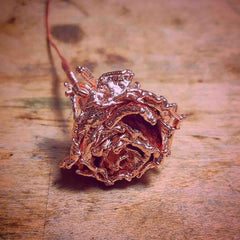The electroforming technique consists of depositing metals on the surface of a given element through the use of electric current. Through this process a thin metal casing is created around any organic or inorganic object.


The procedure takes place in buckets in which an anode and a cathode connected to an electrical transformer and an acid solution are placed. The anode (positive electrode) is connected to the metal to be deposited and the cathode (negative electrode) to the object on which we want to create the metal layers. By applying a direct electric current, metal ions gradually deposit on the object forming a metallic layer.

The electroforming process has its roots in ancient times, but the modern electroforming technique as we know it today developed from the 19th century with the discovery of electrolysis.
In ancient times, techniques such as gilding and silvering were used to coat objects with thin layers of precious metals such as gold and silver. For example, in ancient Egypt, artisans applied gold sheets to statues, sarcophagi and funerary furniture, using hammering and polishing techniques.

In ancient Greece and Rome, similar methods were also used. The embossing technique allowed metal sheets to be embossed, and silvering was used to cover less valuable objects with thin layers of gold or silver. , using amalgams and chemical processes.
While these ancient techniques did not involve the application of electrical current, they laid the foundation for the subsequent development of today's electroforming technique.
At Sophie's in Júpiter we wanted to use this technique to turn any valuable object or object that has a special meaning into a jewel and thus transform it into a memory forever.


